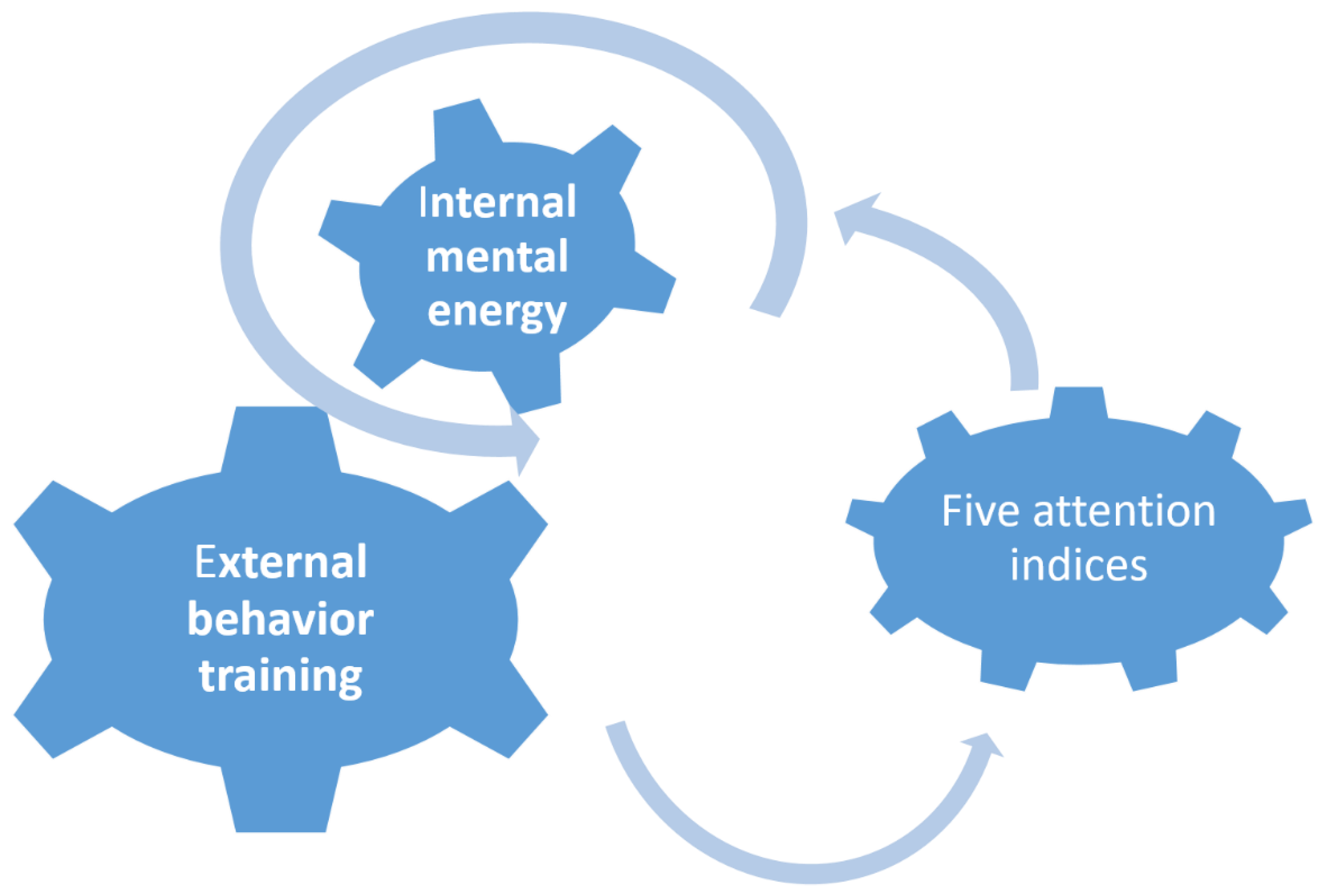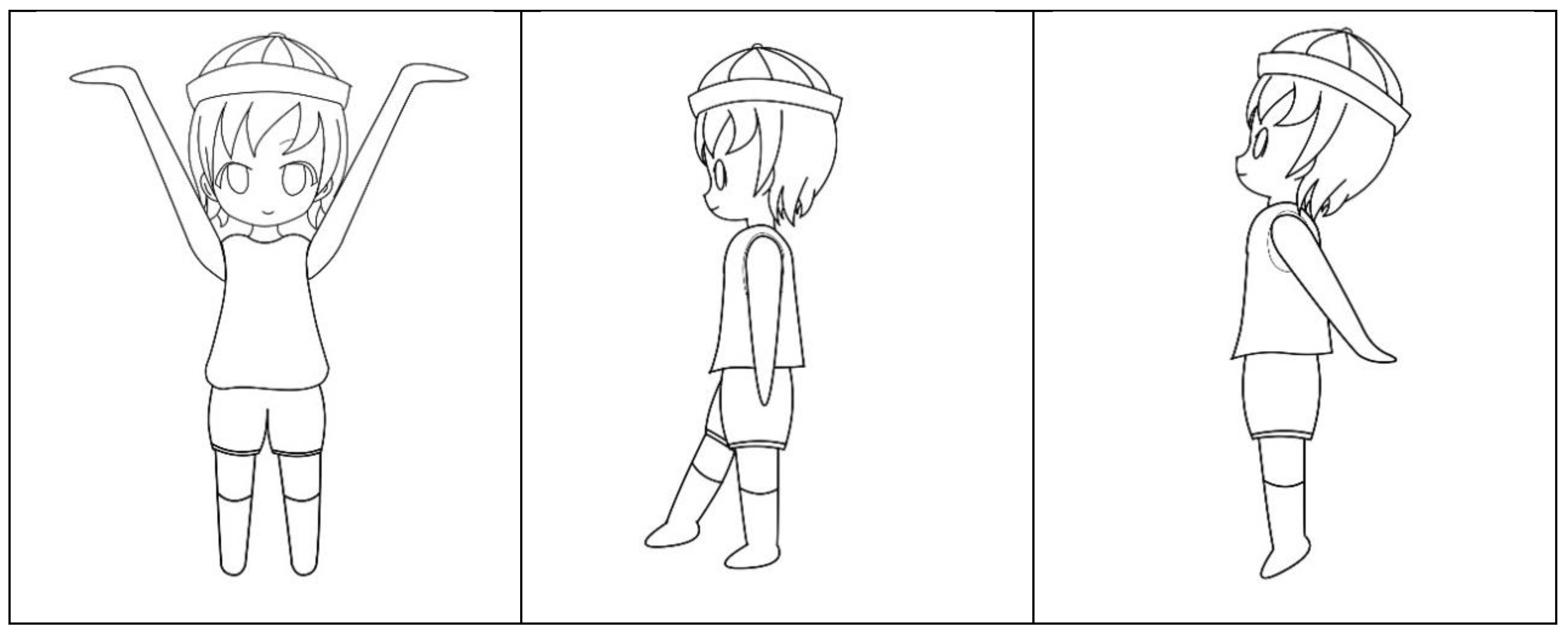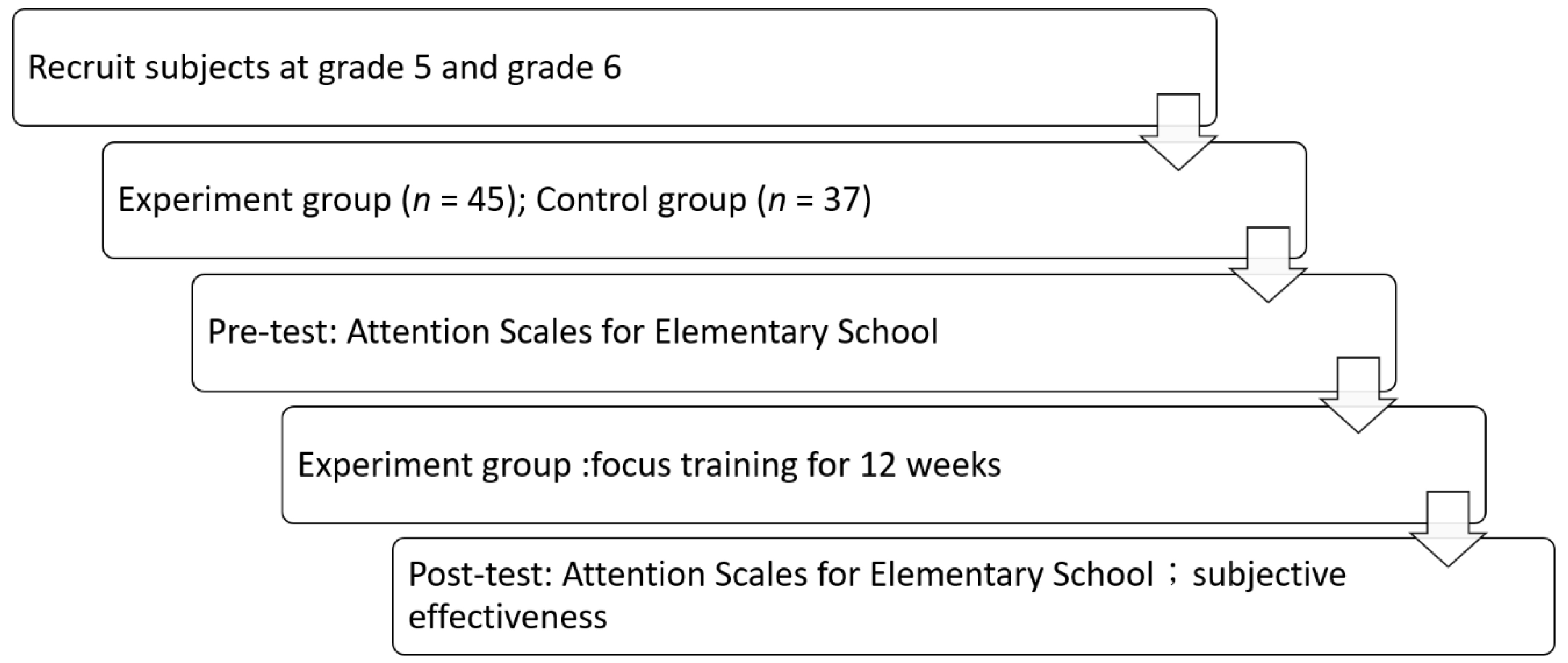Improvement of Attention in Elementary School Students through Fixation Focus Training Activity
Abstract
1. Introduction
- (1)
- Focused attention refers to an individual’s ability to directly respond to specific visual, auditory, or tactile stimuli. Sohlberg and Mateer asserted that focused attention impairment typically occurs in the early stages of recuperation from a coma for patients who sustained brain injury and that focused attention is often the earliest recovered attentional function for such patients.
- (2)
- Sustained attention is the ability to maintain consistent behavioral responses during continuous or repetitive activities. Individuals who experience impairment in this attentional dimension can only focus transiently on a task or maintain a response for several seconds or minutes. They may also exhibit dramatic fluctuation in sustained attention over a short period of time.
- (3)
- Selective attention is an individual’s ability to maintain a behavior or cognitive set when faced with distractions or competing stimuli. Patients deficient in this attentional component can be easily distracted by stimuli that are irrelevant to their original task. These irrelevant stimuli generally include various types of external distractions (stimuli from the external environment such as scenery, sounds, or activity) or internal distractions (an individual’s internal worries, thoughts, or contemplations of personal importance to the individual). Clinically, patients with selective attention deficiency often cannot undergo therapy in a place with other stimuli present.
- (4)
- Alternating attention is an individual’s ability to change the focus of attention and the mental flexibility to shift between tasks with different cognitive requirements. Patients with alternating attention deficiency have difficulty changing from a familiar stimulus–response model. They often require extra prompts to cope with changes of task. This attentional dimension is critical for students, such as when shifting between listening to lectures and writing notes. The cognitive requirements for the two tasks are different. Therefore, students must rely on their mental flexibility to effectively alternate their attention.
- (5)
- Divided attention is an individual’s ability to simultaneously respond to multiple tasks. Individuals engaged in divided attention handle tasks simultaneously across multiple stimuli (e.g., listening to the radio while driving or talking to others while preparing a meal). Under these circumstances, the individual must execute alternating attention rapidly and continuously or rely on subconscious automated procedures to manage one of multiple tasks.
- Q1: Can the attention indices of elementary school students be improved through attention training?
- Q2: Is the ancient Chinese attention training approach, which focuses on changes to the inner state of mind, truly effective for improving the attention of elementary students? If yes, which attention indices are improved?
2. Materials and Methods
2.1. Subject Information
2.2. Experiment Design and Focus Training
- Step 1.
- Sit still for approximately 3 min and wait for all students to arrive.
- Step 2.
- Before the activity commences, remind participants to fixate on a specific point (or figure) on the wall in front of them.
- Step 3.
- Begin the dynamic focus training (approximately 20 min). Throughout the process, consistently remind the students to focus on a fixed point on the wall in front of them.
- Action 1:
- Throw both hands backwards while standing on the toes and slightly tilt the head backwards. Keep attention on the heart.
- Action 2:
- Kick two legs forward in alternation and maintain balance in the upper body while keeping it still. Keep attention on the waist.
- Action 3:
- Bend the knees slightly and shake the whole body. Keep attention on the abdomen near the umbilicus.
- Action 4:
- Keep the body straight and squat slightly. The hands should be kept on both sides of the body, and the palms should be pressed down while parallel to the ground. Keep attention on the knees.
- Action 5:
- Stretch the hands upward vertically and stretch the whole body. The palms should be stretched upward while parallel to the sky. Keep attention on the face.
- Action 6:
- Stretch the hands upward diagonally in a relaxed manner. The two arms should form an approximately 60° angle. Keep attention on the lower heart.
- Action 7:
- Clasp hands together, put them in front of the chest, and squat deeply. Keep attention on the lower abdomen.
- Action 8:
- Walk on the tiptoes without bending the knees. Keep attention on the spine.
- Action 9:
- Tap the back of the head using the fingers while clenching the teeth. Keep attention on the middle of the head.
- Action 10:
- Slap the abdomen using both hands alternatively. Keep attention on the digestive system.
- Step 4.
- After the dynamic training is completed, perform static focus training (approximately 10–15 min). Invite the students to sit down cross-legged. Their hands should be placed on their knees, their back should be straight, and their eyes should be shut lightly. First, invite the students to breathe naturally. After the students’ breathing is stabilized, request that the students focus their attention on different body parts according to the teacher’s instruction. The sequence of focus is the heart, stomach, perineum, caudal vertebrae, lumbar vertebrae, cervical vertebrae, vertex, between the eyes, and the throat. After the students are led through the focus training procedures a few times, they are given the chance to focus on body parts on their own according to this sequence.
- Step 5.
- Conduct an experience-sharing and combined discussion session.
2.3. Parameter Extraction from the Attention Scales for Elementary School Children
2.4. Statistics
- (a)
- The paired sample t-test compared within-group differences between the pretest and post-test results of the experimental and control groups.
- (b)
- The t-test analyzed differences between the experimental and control groups. Three sets of data were analyzed: pretest, post-test, and the post-test–pretest difference.
3. Results
4. Discussion
5. Conclusions
Author Contributions
Funding
Acknowledgments
Conflicts of Interest
Appendix A
References
- Sohlberg, M.M.; Mateer, C.A. Effectiveness of an attention-training program. J. Clin. Exp. Neuropsychol. 1987, 9, 117–130. [Google Scholar] [CrossRef]
- Lue, W.-C.; Lin, G.-H.; Lee, S.-C.; Hsieh, C.-L. Development and Validation of a Computerized Alternating Attention Test (CAAT) in Patients with Schizophrenia. Am. J. Occup. Ther. 2019, 73, 18. [Google Scholar] [CrossRef]
- Lin, G.-H.; Yang, Y.-P.; Yang, J.-F.; Chen, T.-T.; Hsieh, C.-L. Reducing the time needed to administer a sustained attention test in patients with stroke. PLoS ONE 2018, 13, e0192922. [Google Scholar] [CrossRef]
- Bussing, R.; Fernandez, M.; Harwood, M.; Hou, W.; Garvan, C.W.; Eyberg, S.M.; Swanson, J.M. Parent and teacher SNAP-IV ratings of attention deficit hyperactivity disorder symptoms: Psychometric properties and normative ratings from a school district sample. Assessment 2008, 15, 317–328. [Google Scholar] [CrossRef]
- Yu, W.-H.; Chiu, E.-C.; Lin, G.-H.; Lin, H.-Y.; Hsueh, I.-P.; Hsieh, C.-L. Test-retest Agreement, Random Measurement Error and Practice Effect of the Attention Scale for Elementary School Children. J. Occup. Ther. Assoc. R.O.C. 2015, 33, 25–44. [Google Scholar]
- Mahar, M.T. Impact of short bouts of physical activity on attention-to-task in elementary school children. Prev. Med. 2011, 52, S60–S64. [Google Scholar] [CrossRef] [PubMed]
- Schmidt, M.; Benzing, V.; Kamer, M. Classroom-based physical activity breaks and children’s attention: Cognitive engagement works! Front. Psychol. 2016, 7, 1474. [Google Scholar] [CrossRef] [PubMed]
- Crescentini, C.; Capurso, V.; Furlan, S.; Fabbro, F. Mindfulness-Oriented Meditation for Primary School Children: Effects on Attention and Psychological Well-Being. Front. Psychol. 2016, 7, 699. [Google Scholar] [CrossRef] [PubMed]
- Tarrasch, R. Mindful Schooling: Better Attention Regulation Among Elementary School Children Who Practice Mindfulness as Part of Their School Policy. J. Cogn. Enhanc. 2017, 1, 84–95. [Google Scholar] [CrossRef]
- Mak, C.; Whittingham, K.; Cunnington, R.; Boyd, R.N. Efficacy of Mindfulness-Based Interventions for Attention and Executive Function in Children and Adolescents—A Systematic Review. Mindfulness 2018, 9, 59–78. [Google Scholar] [CrossRef]
- Chang, K.-M.; Chueh, M.-T.W. Using Eye Tracking to Assess Gaze Concentration in Meditation. Sensors 2019, 19, 1612. [Google Scholar] [CrossRef] [PubMed]
- Cerezo, E.; Coma, T.; Blasco-Serrano, A.C.; Bonillo, C.; Garrido, M.Á.; Baldassarri, S. Guidelines to design tangible tabletop activities for children with attention deficit hyperactivity disorder. Int. J. Hum.-Comput. Stud. 2019, 126, 26–43. [Google Scholar] [CrossRef]
- Shereena, E.; Gupta, R.; Bennett, C.; Sagar, K.; Rajeswaran, J. EEG Neurofeedback Training in Children with Attention Deficit/Hyperactivity Disorder: A Cognitive and Behavioral Outcome Study. Clin. EEG Neurosci. 2018, 50, 242–255. [Google Scholar] [CrossRef] [PubMed]
- Liu, M.; Zhang, J.; Jia, W.; Chang, Q.; Shan, S.; Hu, Y.; Wang, D. Enhanced executive attention efficiency after adaptive force control training: Behavioural and physiological results. Behav. Brain Res. 2019, 376, 111859. [Google Scholar] [CrossRef] [PubMed]
- Kosmyna, N.; Morris, C.; Sarawgi, U.; Maes, P. AttentivU: A Biofeedback System for Real-time Monitoring and Improvement of Engagement. In Proceedings of the Extended Abstracts of the 2019 CHI Conference on Human Factors in Computing Systems, New York, NY, USA, 4–9 May 2019; pp. 1–2. [Google Scholar]
- Shema-Shiratzky, S.; Brozgol, M.; Cornejo-Thumm, P.; Geva-Dayan, K.; Rotstein, M.; Leitner, Y.; Hausdorff, J.M.; Mirelman, A. Virtual reality training to enhance behavior and cognitive function among children with attention-deficit/hyperactivity disorder: Brief report. Dev. Neurorehabilit. 2018, 22, 431–436. [Google Scholar] [CrossRef] [PubMed]
- Lorenzo, G.; Puerta, M.; Arráez-Vera, G.; Lorenzo-Lledó, A. Preliminary study of augmented reality as an instrument for improvement of social skills in children with autism spectrum disorder. Educ. Inf. Technol. 2019, 24, 181–204. [Google Scholar] [CrossRef]
- Barbaroux, M.; Dittinger, E.; Besson, M. Music training with Démos program positively influences cognitive functions in children from low socio-economic backgrounds. PLoS ONE 2019, 14, e0216874. [Google Scholar] [CrossRef]
- Sprawson, I.; Wood, J.; Mantzios, M. “And Now Close Your Eyes or Lower Your Gaze”: Exploring Novice Meditators and Their Attentional Processes During Meditation. J. Cogn. Enhanc. 2020, 1–10. [Google Scholar] [CrossRef]
- Halperin, J.M. The clinical assessment of attention. Int. J. Neurosci. 1991, 58, 171–182. [Google Scholar] [CrossRef]
- Booth, J.R.; Burman, D.D.; Meyer, J.R.; Lei, Z.; Trommer, B.L.; Davenport, N.D.R.; Li, W.; Parrish, T.B.; Gitelman, D.R.; Mesulam, M.M. Neural development of selective attention and response inhibition. NeuroImage 2003, 20, 737–751. [Google Scholar] [CrossRef]
- Kabat-Zinn, J. Mindfulness-Based Interventions in Context: Past, Present, and Future. Clin. Psychol. Sci. Pract. 2003, 10, 144–156. [Google Scholar] [CrossRef]
- Chang, K.-M.; Chueh, M.-T.W.; Lai, Y.-J. Meditation Practice Improves Short-Term Changes in Heart Rate Variability. Int. J. Environ. Res. Public Heal. 2020, 17, 2128. [Google Scholar] [CrossRef] [PubMed]
- Gong, H.; Ni, C.; Liu, Y.-Z.; Zhang, Y.; Su, W.-J.; Lian, Y.-J.; Peng, W.; Jiang, C.-L. Mindfulness meditation for insomnia: A meta-analysis of randomized controlled trials. J. Psychosom. Res. 2016, 89, 1–6. [Google Scholar] [CrossRef] [PubMed]
- Manocha, R.; Black, D.; Sarris, J.; Stough, C. A Randomized, Controlled Trial of Meditation for Work Stress, Anxiety and Depressed Mood in Full-Time Workers. Evid.-Based Complement. Altern. Med. 2011, 2011, 1–8. [Google Scholar] [CrossRef] [PubMed]
- De Fockert, J.W.; Rees, G.; Frith, C.D.; Lavie, N. The Role of Working Memory in Visual Selective Attention. Science 2001, 291, 1803–1806. [Google Scholar] [CrossRef] [PubMed]
- Lavie, N. Perceptual load as a necessary condition for selective attention. J. Exp. Psychol. Hum. Percept. Perform. 1995, 21, 451. [Google Scholar] [CrossRef]
- Mohamed, Z.; El Halaby, M.; Said, T.; Shawky, D.; Badawi, A. Characterizing Focused Attention and Working Memory Using EEG. Sensors 2018, 18, 3743. [Google Scholar] [CrossRef]
- Benedek, M.; Schickel, R.J.; Jauk, E.; Fink, A.; Neubauer, A.C. Alpha power increases in right parietal cortex reflects focused internal attention. Neuropsychologia 2014, 56, 393–400. [Google Scholar] [CrossRef]



| Ref No. | Researcher | Training Method | Corresponding Attention Indices | Participants | Country/Region | Year |
|---|---|---|---|---|---|---|
| [6] | Mahar | Physical activity | N.A. | 8 and 9 years | USA | 2011 |
| [7] | Schmidt et al. | Physical activity | d2-R, focused attention | 11 years | Switzerland | 2016 |
| [8] | Crescentini et al. | Mindfulness-based interventions | No significant decrease in SMFQ scores (Short Mood and Feelings Questionnaire) | 7–8 years | Italy | 2016 |
| [9] | Tarrasch | Mindfulness-based interventions | Higher proportion of correct trials in the Stroop task | 2nd, 4th, and 6th grades | Israel | 2017 |
| [10] | Mak et al. | Mindfulness or meditation interventions | At least one outcome measure of attention | Review article | Australia | 2017 |
| [12] | Cerezo et al. | Tabletop games | N.A. | ADHD | Spain | 2019 |
| [13] | Shereena et al. | Neurofeedback | Sustained attention, verbal working memory, and response inhibition | ADHD | India | 2019 |
| [14] | Liu et al. | Fingertip-based adaptive force control tasks | Attention network test and response time | 22 and 26 years | China | 2019 |
| [15] | Kosmyna et al. | Biofeedback glasses | N.A. | N.A. | USA | 2019 |
| [16] | Shema-Shiratzky et al. | Virtual reality training | Executive function and memory | ADHD | Israel | 2019 |
| [17] | Lorenzo et al. | Augmented reality | N.A. | Autism | Spain | 2018 |
| [18] | Barbaroux et al. | Music training | Visuomotor Precision test (NEPSY-II) | 7 to 12 years | France | 2019 |
| [19] | Sprawson et al. | Mindfulness meditation | HEXACO-60-PI | 18 to 33 years | UK | 2020 |
| Item | Experimental Group | Control Group |
|---|---|---|
| Total subject number | 45 | 37 |
| Male/female | 22/23 | 13/24 |
| Number of grade 6 students (12 years old) /number of grade 5 students (11 years old) | 36/9 | 37/0 |
| Attention Type | Experimental Group | Control Group | Experimental Group vs. Control Group | ||||||||
|---|---|---|---|---|---|---|---|---|---|---|---|
| Pre-Test | Post-Test | DIFF | P1a | Pretest | Post-test | DIFF | P1b | Before P2 | After P3 | P4 DIFF | |
| Total scale | 46.07 (29.28) [96.0] <3.0> | 73.27 (26.64) [99.0] <4.0> | 27.20 (20.39) [68.0] <1.0> | *** | 51.21 (27.83) [95.0] <1.0> | 70.13 (25.01) [98.0] <1.0> | 18.92 (16.74) [50.0] <−14.0> | *** | * | ||
| Focused | 45.13 (29.33) [98.0] <4.0> | 63.20 (29.05) [99.0] <4.0> | 18.07 (31.84) [86.0] <−80> | *** | 49.16 (25.68) [99.0] <0.1> | 54.40 (25.64) [98.0] <0.1> | 5.24 (21.80) [54.0] <−38.0> | * | |||
| Sustained | 36.65 (28.83) [97.0] <0.2> | 61.03 (33.12) [99.0] <0.2> | 24.37 (25.19) [78.0] <−18.0> | *** | 42.22 (26.90) [95.0] <0.2> | 70.00 (23.65) [99.9] <0.2> | 27.79 (17.76) [65.0] <0> | *** | |||
| Selective | 70.20 (26.44) [99.0] <9.0> | 90.58 (15.10) [99.0] <20.0> | 20.38 (22.95) [87.0] <−11.0> | *** | 73.26 (26.04) [99.0] <3.0> | 81.58 (24.44) [99.0] <1.0> | 8.32 (21.14) [67.0] <−23.0> | * | * | ** | |
| Alternating | 58.19 (28.14) [99.0] <0.4> | 74.91 (27.78) [99.0] <0.1> | 16.73 (20.32) [76.0] <−41.9> | *** | 52.45 (27.04) [94.0] <0.1> | 60.79 (27.69) [97.0] <1.0> | 8.34 (25.91) [72.0] <−53.0> | * | * | ||
| Divided | 36.57 (27.49) [90.0] <0.1> | 51.52 (31.22) [96.0] <0.2> | 14.95 (21.61) [60.0] <−26.0> | *** | 40.01 (26.36) [96.0] <0.2> | 61.29 (28.20) [96.0] <0.2> | 21.29 (23.46) [64.0] <−21.0> | *** | |||
| Experience | Improved Concentration during School Lessons | Falling Asleep Faster at Night | Feeling Relaxed | Feeling Less Stress | Alleviated Chest Pain |
|---|---|---|---|---|---|
| Percentage | 54.1% | 29.1% | 8.4% | 4.2% | 4.2% |
© 2020 by the authors. Licensee MDPI, Basel, Switzerland. This article is an open access article distributed under the terms and conditions of the Creative Commons Attribution (CC BY) license (http://creativecommons.org/licenses/by/4.0/).
Share and Cite
Lai, Y.-J.; Chang, K.-M. Improvement of Attention in Elementary School Students through Fixation Focus Training Activity. Int. J. Environ. Res. Public Health 2020, 17, 4780. https://doi.org/10.3390/ijerph17134780
Lai Y-J, Chang K-M. Improvement of Attention in Elementary School Students through Fixation Focus Training Activity. International Journal of Environmental Research and Public Health. 2020; 17(13):4780. https://doi.org/10.3390/ijerph17134780
Chicago/Turabian StyleLai, Yi-Jung, and Kang-Ming Chang. 2020. "Improvement of Attention in Elementary School Students through Fixation Focus Training Activity" International Journal of Environmental Research and Public Health 17, no. 13: 4780. https://doi.org/10.3390/ijerph17134780
APA StyleLai, Y.-J., & Chang, K.-M. (2020). Improvement of Attention in Elementary School Students through Fixation Focus Training Activity. International Journal of Environmental Research and Public Health, 17(13), 4780. https://doi.org/10.3390/ijerph17134780




